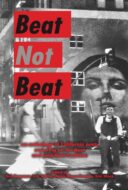 Beat Not Beat: An Anthology of California Poets Screwing on the Beat and Post-Beat Generation
Beat Not Beat: An Anthology of California Poets Screwing on the Beat and Post-Beat Generation
Edited by Rich Ferguson, S.A. Griffin, Alexis Rhone Fancher, Kim Shuck
Moon Tide Press
Reviewer: Brian Fanelli
Beat Not Beat, edited by Rich Ferguson, S.A. Griffin, Alexis Rhone Fancher, and Kim Shuck, may be an anthology inspired by the Beat movement of the 1950s and early 1960s, but it’s not an anthology that houses the writing of Allen Ginsberg, Jack Kerouac, William S. Burroughs, or some of the other well-known figures. There are enough anthologies out there that feature their work. And while this anthology does contain some rather familiar names, such as Philip Levine, Robert Hass, Kim Addonizio, and even Charles Bukowski, as well as a few poems about Bukowski, this anthology showcases poets who will likely be a first-time read for many. This diverse collection of names and sprawling compilation confirm the far-reaching and long-lasting influence of the Beat writers.
In terms of subject matter, Beat Not Beat is expansive. Some of the longer, politically charged poems that rail against consumerism, environmental devastation, and late-stage capitalism certainly echo Ginsberg’s “Howl,” just without countless references to Moloch. Take, for instance, “Calling 21st Century Poets” by Dr. Mongo, a performance artist, poet, and long-standing staple of the L.A. poetry scene until his death in 2019. The poem feels inspired by the performative nature of the Beat movement and the far-left politics of Ginsberg. The poem calls on 21st Century poets to “rail against government-sponsored / drug prohibition, agricultural arsonists’ -/ armed global Juggernauts – / financed by the military-industrial complex, / carrying out scored earth policies / with search and destroy brutality / in our backyards and homes.” While Dr. Mongo’s poem may be more direct than Ginsberg’s work, it certainly contains that transgressive spirit inherent to the Beat Generation.
In terms of form, there are even poems that resemble some of the most famous works from the Beat era. D.A. Powell’s “Don’t Touch My Junk,” as an example, very much mirrors “Pull My Daisy,” a collaborative poem by Ginsberg, Kerouac, and Neal Cassady. While their collaboration comes across as mere word play, Powell adds a sexual flair and charge:
I strip
for tips
it’s pits
it’s hit
or miss
you sit
unzip
and spit
on it
but it’s
a trip
my trick?
From there, the poem becomes even more sexually explicit, again mirroring the non-conformity and confrontational nature of the Beats.
While the anthology generally excludes some of the most famed writers of the movement, there are some literary treasures not seen elsewhere. One criticism of the Beat movement is that it often placed the male writers front and center, excluding the women and wives who were also writers. This book, however, contains work by Carolyn Cassady, wife of Neal Cassady, the inspiration for Kerouac’s On the Road. “Poetic Portraits” offers the reader glimpses into interactions between Cassady and Ginsberg, some of which were drawn from files Carolyn Cassady saved. It’s difficult to say if these are based on journals or simple notes about conversations Neal had with Ginsberg, but they read like simple sketches. For example:
Amazing- Allen
You teach young minds
That Art is easy-
Be a poet!
Be degenerate!
Be bitter of heart and
Shriven of soul-
Squirt words
Not from Spirit
But from spit
Doped-and acid
Semen
In the last section of “Poetic Portraits,” we’re again treated to mere glimpses and reflections on the Beat movement by someone who was an active player in it. She writes:
There is life inside of me
But I have lived another
Strains of music, sudden scenes
A certain kind of afternoon
Old flashes of an empathy
That came to pass too soon.
There is a life I meant to live
But I have lived another …
Those last two lines feel especially poignant. They open up the question of whether Carolyn Cassady wanted to forge her own career as a writer but was overshadowed by the men of the movement, particularly her husband. Regardless, it’s interesting to hear her perspective. The anthology even features a third anniversary poem that Neal wrote for Carolyn. These little moments and special inclusions should make this anthology worth the price for fans of the Beat movement. You’re unlikely to locate these pieces elsewhere.
Other poems address what happens when a writer tries to reconcile maintaining that youthful spirit well into adulthood. “Smolder” by Eric Morago is interesting if you consider that too many of the Beat writers, like Kerouac and Cassady, died young. Ginsberg may have maintained his political fire into old age, as did Lawrence Ferlinghetti, but would the others have, had they lived just as long? Kerouac became quite conservative before drinking himself to death. “Smolder” is a haunting poem because it tackles that feeing of losing youthful resilience and that spirit of protest. His poem begins with images of a fire burning along the highway and cars pulling over to the shoulder of the road, so drivers can watch. Morago then uses fire as a metaphor for the passion he felt when younger. “But I used to scorch,” he writes, “used to feel my heart swell / so red I thought a devil / lived in my chest, spiking / my poetry like punch at prom.” A few stanzas later, he adds, “That was before a mortgage,” continuing that he now makes a “manager’s salary” and spends more time writing emails than poems. This piece longs for that youthful spark. It’s an incredibly relatable feeling and also begs the question: what poems would Kerouac have written if he survived past 1969? What about Cassady? What about Ginsberg if he was ever forced to work an office job, like his time writing ads? Morago’s poem is a clear-eyed look at the difficulty in maintaining that fire when bills must be paid.
Overall, if you’re looking for an anthology that contains the work of some of the most famous Beat Generation writers, this isn’t it. First of all, the anthology is limited to California poets, and the Beats thrived in New York City as much they it did in San Francisco. Many of the familiar writers met at Columbia. That said, there are still poems in here by the Cassadys, Snyder, and Ferlinghetti. S.A. Griffin admits in the afterword, “Not everything or everyone included in this book is Beat, or pretends to be.” He continues, “This book has been curated in such a way that it is Beat in origin and association moving in all directions at once to achieve a greater dynamic.” Indeed, this is true. The pleasure of reading this anthology is its scope and depth. There are poems here clearly influenced by the Beat canon, in terms of content and form, but others move in different directions, as Griffin puts it. Likely, a reader will come away with several poets to check out for the first time, who were either part of the movement or inspired by it. This is the most unique take on the Beat movement that I’ve had the pleasure of reading.

